
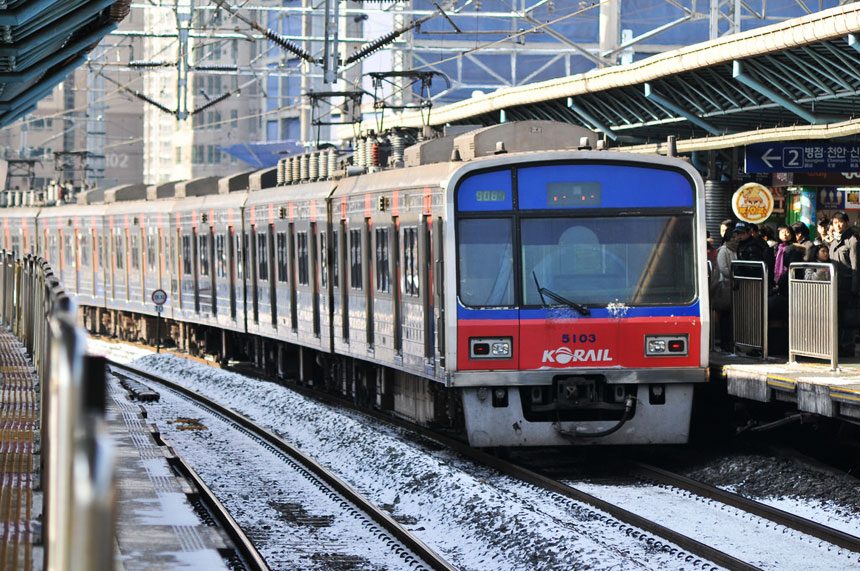 Image credit: Doo Ho Kim/Flickr
Image credit: Doo Ho Kim/FlickrSeoul is a mega city with one of the best public transport systems in the world. Its extensive subway and bus networks cover the entire city, so you can reach any destination in Seoul just with the help of public transport means.
Using subway and bus is a wise way to save cost for your Seoul trip. Very soon after hitting Insadong and Myeongdong shopping district, you will realize that you need more money to shop more and eat more. If you can’t increase your budget, then ride public vehicles instead of taxis to have some more Wons for enjoying Seoul fashion and cuisine.
In this list, you will find reviews on both public and private transport means, with pros and cons included for your consideration.
See also: Best Ways to Get from Seoul Incheon Airport to City
Just like most other major cities in the world, Seoul is offering discounts for using public transportation if you pay via a special transportation card.
T-Money card
That transportation card in Seoul is the T-Money card, which can be used on pretty much all modes of transportation in the city, including metro, bus and even taxis.
T-Money gives you a 100 won ($0.09) fare discount for metro and buses, as well as additional transfer discounts between buses and metro lines.
The T-Money card is either prepaid or postpaid (using a credit card). The prepaid T-Money card costs 2,500 won ($2.2) and can be purchased at every metro station or convenient stores (7-Eleven, CU, GS 25, etc.).
If you’re leaving Seoul and you still have some money on the card, you can get a refund for the remaining balance after a 500 won ($0.44) service charge.
M-Pass card
There is also the M-Pass card, which was made for tourists who need to use Seoul public transportation multiple times per day for several days.
You use the M-Pass card for free rides up to 20 times a day regardless of the distance for 1 to 7 days (depending on which type of M-Pass card you purchase).
The card can be used on most subways and public buses, and it can also serve as the regular T-Money card (M-Pass card has built-in T-Money function) if you load it up with additional funds.
You can purchase the M-Pass card at the tourist information center on the 1st floor of the Incheon International Airport (in front of Exit 5 and Exit 10).
The price of the M-Pass card depends on the card type: 1-day 10,000 won ($8.81); 2-day 18,000 won ($15.86); 3-day 25,500 won ($22.46); 5-day 42,500 won ($37.44) and 7-day 59,500 won ($52.42).
The M-Pass card is valid for one month from the date of the purchase. The card is activated upon first use and expires at 23:59 of the last day. For example, if you start using the 2-day M-Pass card today, it will be expired at 23:59 tomorrow.
Seoul City Pass card
Seoul also has Seoul City Pass cards, which combine the benefits of T-Money cards with providing discounts for certain tourist attractions, exhibitions and restaurants.
With the Seoul City Pass card, you can use metro lines and public buses for free up to 20 times per day. You can also enjoy discounts on the fares of Seoul City Tour Buses, which travel around the city and stop at many tourist attractions.
Seoul City Pass cards are available for purchasing at tourist information centers, subway stations, and convenience stores including those stores at Incheon Airport’s Arrivals Hall.
The card is available at 15,000 won ($13.21) for 1-day pass; 25,000 won ($22) for 2-day pass; and 35,000 won ($30.83) for 3-day pass.
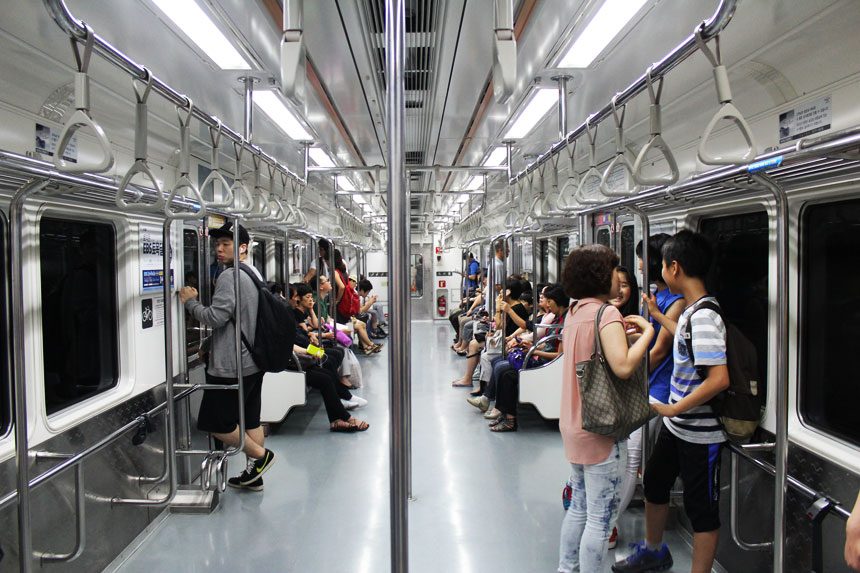 Image credit: yadem.hayseed/Flickr
Image credit: yadem.hayseed/FlickrTaking a ride on subway is a fast, convenient and cheap way to get around in Seoul and reach any area of the city.
Seoul Metropolitan Subway has 18 lines in operation. Each line has its own name and designated color, which makes it easy to use this mode of transportation.
The subway also has clear signs and detailed maps in English on each station. It’s also quite easy to estimate your traveling time from your starting point to your destination. Because it usually takes about 2 minutes to travel between two stations.
You’ll have to pay a 500 won ($0.44) deposit when buying a single-journey ticket at the ticket vending machine. You can get back the deposit at the ticket returning machine at the arrival station.
It’s more convenient if you use T-Money cards as you don’t need to pay the deposit.
What is even better about using T-Money cards is that you can transfer from and to metro and buses up to 5 times for no additional fees. Note that free transfer only applies when you get on the other metro or bus within 30 minutes (or within 1 hour from 21:00 to 07:00) after you get off the previous one.
Subway hours: Vary depending on the line, generally from 05:30 to 01:00 on weekdays; and 05:30 to 00:00 on weekends
Subway schedule: Every 2 – 3 minutes during peak hours, and 5 – 7 minutes at non-peak hours
Subway fares: 1,250 won ($1.1) per first 10 km, then 100 won ($0.09) for each subsequent 5 km, and after 50 km 100 won ($0.09) for each subsequent 8 km
Notes
– Fares above are provided for T-Money cards. If you’re using a single-journey ticket, you’ll have to pay 100 won more ($0.09).
– If you’re traveling with a bicycle, the only way to bring it on a train is either in the front or back cars.
– Get a detailed Seoul Metropolitan Subway map here.
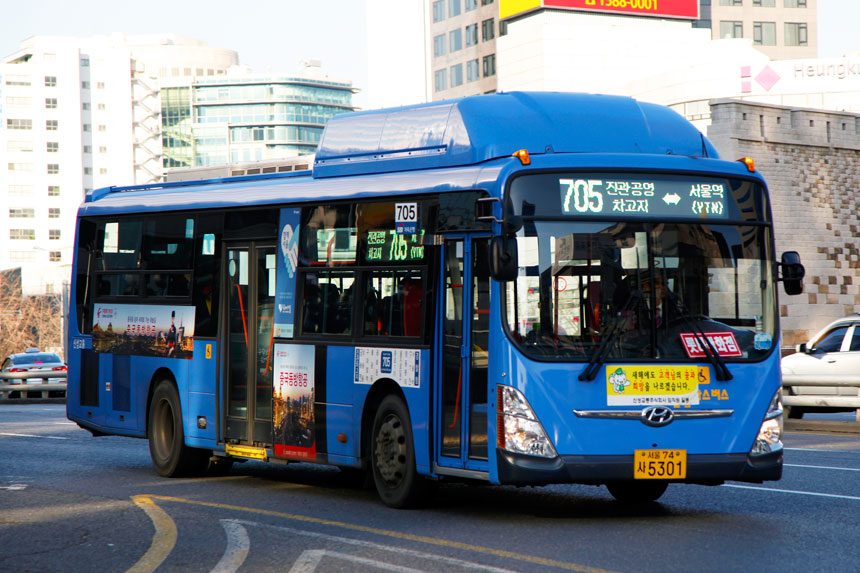 Image credit: byeangel/Flickr
Image credit: byeangel/FlickrUsing a public bus is an affordable and quick way to get around in Seoul. However, it may be confusing for a foreigner to use buses in Seoul because most buses don’t have signs in English.
There are four types of Seoul buses, which are color-coded: Blue, Green, Yellow and Red.
Blue buses run long-distance trips and link central Seoul with the city’s suburbs.
Green buses do short-distance trips and connect subway stations and major blue bus routes with residential areas. There are also green mini buses that run short-distance trips within a district or neighborhood.
Yellow buses run circular trips in central Seoul and connect major shopping and tourist areas. These buses provide travelers a fun and cheap way to get around and explore central Seoul.
Red buses do express routes between Seoul and the city’s metropolitan area. Red buses don’t offer discounts even if you’re using a transportation card and are best used to go to places such as Suwon and Incheon.
Taking a bus in Seoul during rush hours is not a good idea as they tend to get crowded. And using a bus in Seoul while not knowing some Korean won’t get you far (… or will get you so far you’ll need hours to get out of there).
It is best to have your destinations written on a piece of paper (to show bus drivers later) if you want to explore the city on buses.
Bus hours: Vary depending on the route, but most routes service from 04:30 to 01:00 every day
Bus schedule: 5 to 15 minutes
Bus fares
– Blue and green buses: 1,050 won ($0.92) first 10 km, then from 10 km 100 won ($0.09) for every 5 km
– Yellow buses: 850 won ($0.75) first 10 km, then from 10 km 100 won ($0.09) for every 5 km
– Red buses: 1,850 won ($1.63) first 10 km, then from 10 km 100 won ($0.09) for every 5 km
Notes
– Fares above are provided for T-Money cards. If you’re using a single-journey card, you’ll have to pay 100 won more ($0.09).
– If you are using T-Money cards, transfer from and to metro and buses up to 5 times for no additional fees. Free transfer only applies when you get on the other metro or bus within 30 minutes (or within 1 hour from 21:00 to 07:00) after you get off the previous one.
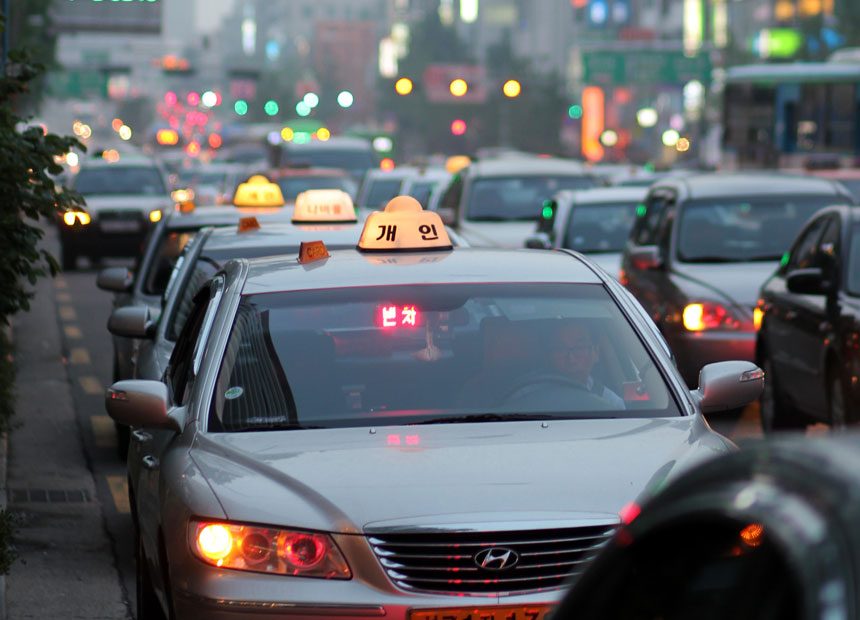 Image credit: Hyunwoo Sun/Flickr
Image credit: Hyunwoo Sun/FlickrGetting around in Seoul using a taxi is not cheap. But it can bring you anywhere you want anytime and saves you from the trouble of having to figure out how to use the city’s metropolitan subway or buses.
If you want to have smooth taxi rides in Seoul, void using the service during rush hours. Because it is when Seoul drivers have to deal with traffic jams that happen quite often.
There are four types of taxis in Seoul: regular taxi (orange, white or grey color), deluxe taxi (black color with ‘deluxe’ written on the door), jumbo taxi (7-seater black color) and international taxi (black or orange with ‘International’ written on the door).
Regular, deluxe, and international taxis can seat up to 4 passengers, while jumbo taxis can seat up to 9 passengers.
Deluxe taxis are newer, bigger, and also more expensive than regular taxis.
International taxis, which are designed for foreign visitors in Seoul, have drivers that speak fluent English, Chinese and Japanese. Their fares are higher than regular taxis.
Jumbo taxis are suitable for groups of 5 to 9 people, or passengers with lots of luggage. They are much more expensive than regular taxis.
All taxis in Seoul have a taximeter and most of them accept credit cards and transportation cards (T-Money) for payment. Look for a V-shaped orange card sign on the roof of the taxi to check if it accepts payments via cards.
Taxis can be easily hailed at any area of Seoul, or caught around major hotels and tourist attractions.
Taxi fares
– Regular taxi: 3,000 won ($2.64) per first 2 km, then 100 won ($0.09) per every 142 m
– International taxi: 3,600 won ($3.17) per first 2 km, then 120 won ($0.11) per every 142 m
– Deluxe and Jumbo taxi: 5,000 won ($4.4) per first 3 km, then 200 won ($0.18) per every 164 m
Taxi hours: 24 hours
Notes
– If you’re taking a regular taxi, there is an extra 20% surcharge of the base fare in the period between 00:00 and 03:59. The surcharge doesn’t apply to deluxe and jumbo taxis.
– Most taxis are equipped with GPS, which means you can easily reach your destination.
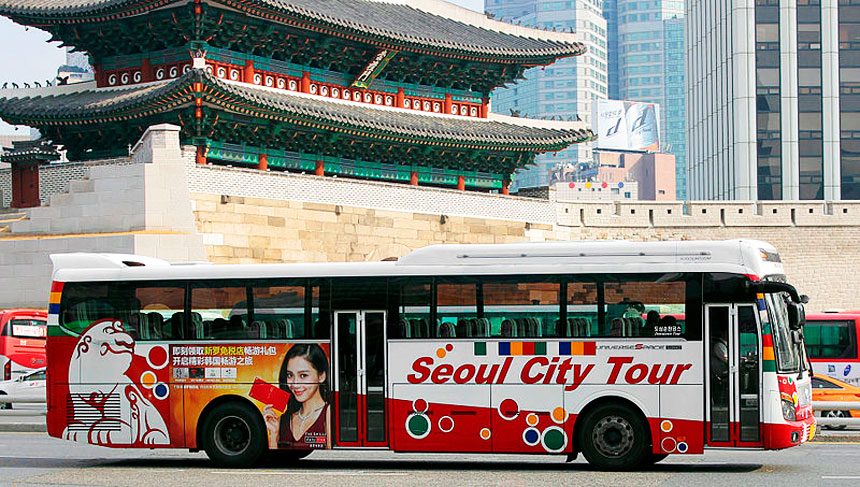 Image credit: Minseong Kim
Image credit: Minseong KimJust like any other major city in the world, Seoul has its own tour buses that allow visitors to explore the city and its tourist attractions.
These tour buses are an ideal option for first-time visitors who want to get to know the city life on streets and major tourist attractions. You just have to pay 12,000 won ($10.57) for a ticket that gives you unlimited access to those hop-on hop-off buses.
The buses follow a circular route that link many city’s attractions such as Seoul Tower, the Gyeongbokgung palaces, Changgyeonggung palaces, Namdaemun markets, and Dongdaemun markets.
Single-decker city buses allow people to go sightseeing around the city, while double-deckers only provide the Seoul Panorama Course tours.
Both single-decker and double-deckers depart from the Gwanghwamun Station (Subway Line 5), Exit 6, near Koreana Hotel.
Service hours: 09:00 – 21:00 Tuesday to Sunday for single-decker, and 09:00 – 17:00 Tuesday to Sunday for double-deckers
Service schedule: Every 30 minutes for single-decker, and every hour for double-deckers
Fares: 12,000 won ($10.57) for single-decker, and 15,000 won ($13.21) for double-deckers
Notes
– Free rides for children under 5.
– If you have Seoul City Pass card, you can enjoy much discounts on the fares, or even take Seoul City Buses for free on some routes.
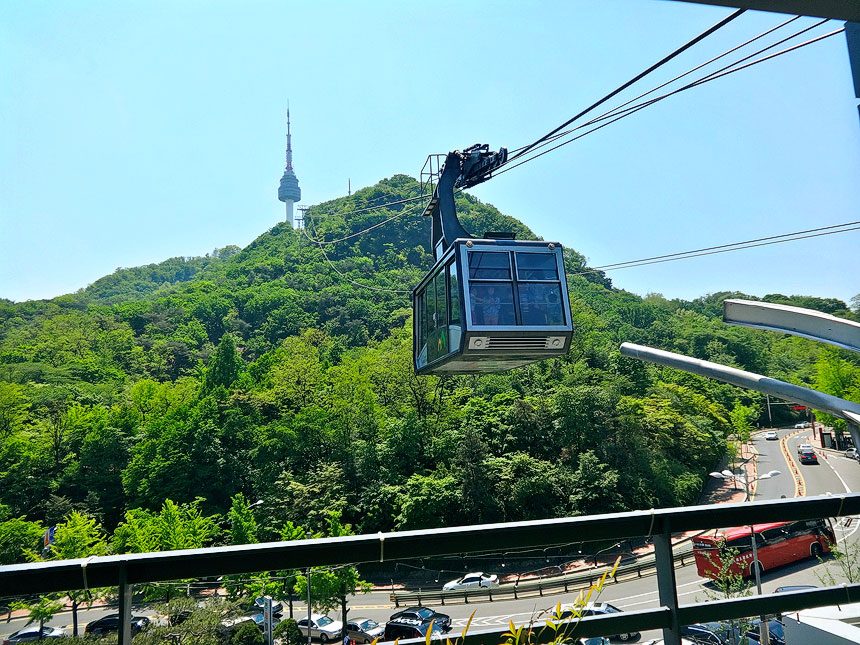 Image credit: Jean & Nathalie/Flickr
Image credit: Jean & Nathalie/FlickrNamsan cable car is an aerial tramway in Seoul, which runs from the base of Namsan Mountain to N Seoul Tower, which is one of the most popular tourist attractions in the city.
Each cable car can carry up to 48 people and has glass on all four sides, allowing riders to explore the beautiful scenery of Seoul’s mountains.
To reach the Namsan cable car, take the Namsan outdoor elevator (Namsan Oreumi), which is Korea’s first-ever inclined outdoor elevator.
The Namsan outdoor elevator can be found about 15 minutes walking distance from Myeong-dong Station (Seoul Subway Line 4). It takes the elevator only 2 minutes to get you to the cable car.
Service hours: 10:00 – 23:00 daily
Service schedule: Every 20 minutes
Fares: 6,000 won ($5.29) one-way ticket and 8,500 won ($7.49) return ticket